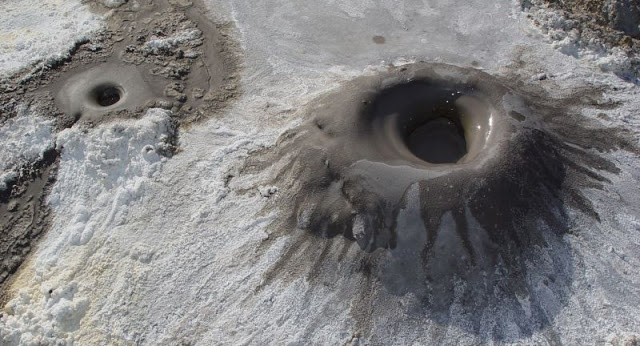
What is Mud volcano?
Mud volcano or mud dome refers to formations created by geo-exuded slurries (usually including water) and gases. There are several geological processes that may cause the formation of mud volcanoes. Mud volcanoes are not true (igneous) volcanoes as they produce no lava. The earth continuously exudes a mud-like substance, which may sometimes be referred to as a “mud volcano”. Mud volcanoes may range in size from merely 1 or 2 meters high and 1 or 2 meters wide, to 700 meters high and 10 kilometers wide. Smaller mud exudations are sometimes referred to as mud-pots. The largest mud volcano, Indonesia’s Lusi, is 10 kilometres (6 mi) in diameter.
The mud produced by mud volcanoes is most typically formed as hot water, which has been heated deep below the earth’s surface, begins to mix and blend with subterranean mineral deposits, thus creating the mud slurry exudate. This material is then forced upwards through a geological fault or fissure due to local subterranean pressure imbalances. Mud volcanoes are associated with subduction zones and about 1100 have been identified on or near land. The temperature of any given active mud volcano generally remains fairly steady and is much lower than the typical temperatures found in igneous volcanoes. Mud volcano temperatures can range from near 100 °C (212 °F) to occasionally 2 °C (36 °F), some being used as popular “mud baths.”
About 86% of the gas released from these structures is methane, with much less carbon dioxide and nitrogen emitted. Ejected materials are most often a slurry of fine solids suspended in water that may contain a mixture of salt, acids and various hydrocarbons.
Possible mud volcanoes have been identified on Mars.
What causes a mud volcano? “Details”
A mud volcano may be the result of a piercement structure created by a pressurized mud diapir that breaches the Earth’s surface or ocean bottom. Their temperatures may be as low as the freezing point of the ejected materials, particularly when venting is associated with the creation of hydrocarbon clathrate hydrate deposits. Mud volcanoes are often associated with petroleum deposits and tectonic subduction zones and orogenic belts; hydrocarbon gases are often erupted. They are also often associated with lava volcanoes; in the case of such close proximity, mud volcanoes emit incombustible gases including helium, whereas lone mud volcanoes are more likely to emit methane.
Approximately 1,100 mud volcanoes have been identified on land and in shallow water. It has been estimated that well over 10,000 may exist on continental slopes and abyssal plains.
Features
- Gryphon: steep-sided cone shorter than 3 meters that extrudes mud
- Mud cone: high cone shorter than 10 meters that extrudes mud and rock fragments
- Scoria cone: cone formed by heating of mud deposits during fires
- Salse: water-dominated pools with gas seeps
- Spring: water-dominated outlets smaller than 0.5 metres
- Mud shield
Emissions
Most liquid and solid material is released during eruptions, but seeps occur during dormant periods.
The mud is rich in halite (rock salt).
First-order estimates of mud volcano emissions have been made (1 Tg = 1 million metric tonnes).
- 2002: L.I. Dimitrov estimated that 10.2–12.6 Tg/yr of methane is released from onshore and shallow offshore mud volcanoes.
- 2002: Etiope and Klusman estimated at least 1–2 and as much as 10–20 Tg/yr of methane may be emitted from onshore mud volcanoes.
- 2003: Etiope, in an estimate based on 120 mud volcanoes: “The emission results to be conservatively between 5 and 9 Tg/yr, that is 3–6% of the natural methane sources officially considered in the atmospheric methane budget. The total geologic source, including MVs (this work), seepage from seafloor (Kvenvolden et al., 2001), microseepage in hydrocarbon-prone areas and geothermal sources (Etiope and Klusman, 2002), would amount to 35–45 Tg/yr.”
- 2003: analysis by Milkov et al. suggests that the global gas flux may be as high as 33 Tg/yr (15.9 Tg/yr during quiescent periods plus 17.1 Tg/yr during eruptions). Six teragrams per year of greenhouse gases are from onshore and shallow offshore mud volcanoes. Deep-water sources may emit 27 Tg/yr. Total may be 9% of fossil CH4 missing in the modern atmospheric CH4 budget, and 12% in the preindustrial budget.
- 2003: Alexei Milkov estimated approximately 30.5 Tg/yr of gases (mainly methane and CO2) may escape from mud volcanoes to the atmosphere and the ocean.
- 2003: Achim J. Kopf estimated 1.97×1011 to 1.23×1014 m³ of methane is released by all mud volcanoes per year, of which 4.66×107 to 3.28×1011 m³ is from surface volcanoes. That converts to 141–88,000 Tg/yr from all mud volcanoes, of which 0.033–235 Tg is from surface volcanoes.
Where Are the Mud Volcanoes?
- Europe
- Asia
- Lusi (Indonesia)
- Central Asia
- Azerbaijan
- Iran
- India
- Pakistan
- Philippines
- Other Asian locations
- China has a number of mud volcanoes in Xinjiang province.
- Some active mud volcanoes are in Oesilo (Oecusse District, East Timor). Arthur Wichmann reports a mud volcano in Bibiluto (Viqueque District), which erupted between 1856 and 1879.
- There are mud volcanoes at the Minn Buu Township, Magway division in Myanmar (Burma).
- There are two active mud volcanoes in South Taiwan and several inactive ones. The Wushan Mud Volcanoes (烏山頂泥火山 in Chinese) are in the Yanchao District of Kaohsiung City. There are active mud volcanoes in Wandan township of Pingtung county.
- There are mud volcanoes on the island of Pulau Tiga, off the western coast of the Malaysian state of Sabah on Borneo.
- A drilling accident offshore of Brunei on Borneo in 1979 caused a mud volcano which took 20 relief wells and nearly 30 years to halt.
- North America
- Yellowstone’s “Mud Volcano”
- South America
- Venezuela
- Colombia
Note: The above post is reprinted from materials provided by Wikipedia.










